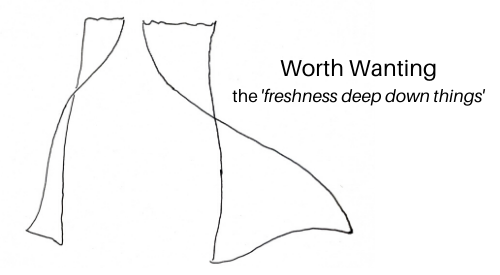
Let’s be clear. Encountering is making common cause with the livingness of an other addressed as ‘you’. It is not a distancing move whereby someone is categorized as different, and less, and over there. Rather it is a solidarity move, where the other is recognized as an ontological peer with a claim on existence as good as our own. It is through encounters with their principle of hospitality, friendship and exploration that transformative freshness acts in and on our world.
One of the things that becomes clear in encounters is that each of us is other to our others, and that what that we attribute to ourselves, we have to recognize in others.
So, are we concrete and individual, recognized and recognizable? So is every other.
Are we apt to insist and resist, with a voice to communicate, and internal complexities and differences to manage. So too every other.
Do we have our own inner life and prospects and point of view evolving uniquely with every decision? Do we exist within a context? So does every other.
Are we possessed of a certain kind of power not entirely dependent, and yet are vulnerable, even fragile? So is every other.
Our differences distinguish us, our commonalities connect us. We are not imcomprehensible blocks of simple material, generic, anonymous, silent, powerless, readily extinguishable, worthless.
Encountering is based on a 180 degree different premise. The other we meet in encounters is our resource, our inspiration, our comrade in concern for our livingness, the way we learn what we are and are not. Others are essential.
Otherness parameters
All of the above suggests that others are only people, and especially those with whom we can readily communicate. Considering the parameters of otherness allow us to expand the category, and make encountering an activity of broader and broader relevance.
We can consider others in terms of mutuality, definiteness, presence, objectivity and number.
By mutuality, I mean capability for interaction. Symbolic means able to communicate by language or other symbols. This means people, but can include pets. Animate mean other living things like plants, able to respond. By inanimate, I mean objects and artifacts like buildings or tools which can only react.
By definiteness, I’m mean the degree of exactness with which the other can be identified. So an other may be immediately present: this house right here. Or specifiable: a certain one with identifying characteristics, say a house in this neighborhood. Or unspecificable: anyone or anything, say any dwelling.
By presence, I’m referring to the kind of immediacy the other has for us. Actual presence: the other as such; inferred presence, the activity of the other evident through its othernesses, or signs indicating its presence; ascribed presence, the as-if presence of the other. So, actual presence: the living author; inferred presence, the author’s works; the ascribed presence, the dead author’s opinion’s plausible opinions.
By objectivity, I mean what’s observable by others or describable to them. Some others are objective at the beginning of the encounter process: a person I converse with on the train. Some others are describable: a question I feel compelled to answer. Finally, some others can be inferred at the reflection end of the encounter process in terms of the production of a judgment or a decision, e.g. a play review, or becoming vegan.
By number, I mean whether the other is a single entity like someone at the other end of the line, or a plural entity like the oeuvre of an artist; or a collective entity like a city.
Typically the term other has referred to single, specified, seeable beings we converse with. But there are many kinds of encounterable others that are authentically other and genuinely encounterable. My wife, say, at one end of the spectrum, and my city Boston at the other.
Encounter parameters
Let’s also remember, before we go further, that there are many ways in which encounters can vary, independent of the type of others that participate in them.
In terms of directness, some encounters are without mediation, a panel discussion, for instance; some a mix, speech supplemented by writings by the speakers; and some entirely mediated, a historical account of the debate.
In terms of timing, some encounters trigger immediate responses; some have a lagged response, and some are slow-acting, responding after a long latency.
In terms of plasticity, some encounters produce phenotype-level adjustments, immediately observable. Some produce genotype-level changes, transmissible to future generations of encounters. Some produce a mix: changes that modify an environment that have the effect of favoring certain long term changes.
In terms of duration, some encounters are spontaneous or accidental; some are specially scheduled like appointments; and some are routine, like work meetings.
In terms of intensity, some encounters are intense and concentrated in their impact, like storms; other encounters have localized intensity, like weather patterns; yet other encounters have a diffuse kind of impact, like climate.
Types of others
I’ve added to this list from time to time and so it may not be final.
Outer Others
[The biggest distinction in the types of others is between our outer others, observable at the outset of the encounter, and our inner others, observable at the reflection end of the process. It can happen that the reflection end of an encounter with an outer other can lead to a question serving as an inner other.]
-Face to face
-F to F regarding the others also in a common KNOIT
-F to F regarding others who do not share common membership in particular KNOIT
[It’s often the case that many of our encounters are not with strangers, but with those with whom we share membership in a kinship group, neighborhood, organization, institution or tradition (KNOIT). Indirectly any encounter we have with one has implications on all the members, so these specifiable other are indirectly involved in the encounter. The many with whom we don’t share common membership are unspecifiable others who also have an interested, albeit even more indirect, in the encounter. The stance of hospitality, friendship and exploration that characterizes direct encounters extends to even indirect ones. Typically, this is evident when any two in an encounter address implications for their common KNOIT or those implications on the wider world. So for instance, a US senator can address the concerns of the person he or she is talking to, their common concern for the institution they belong to, and even more remotely, the interests of the citizens of the nation.]
-Objects and artifacts, such as specimens and art works we examine closely and come to know well
-Our body, and what it does with us and in spite of us.
-Our duty as conventionally endorsed and enforced, such as traffic laws
-Our niche: the physical environment we construct to ensure our survival, comfort and dignity (particularly when we are trying to change or having to adjust)
-Instructions: such as a musical score we are try to play
-An outer plenitude, such as a foriegn city we visit
-Transcendent freshness itself, as it invites us continually to exercise our livingness
Inner others
[It can also happen that something objective can activate our inner others (more like othernesses, concrete expressions of different aspects of ourselves) and prompt inner colloquy toward some public judgment or decision.]
-Our heritage: where and who we came from (especially when some event causes us consider our identity and responsibility)
-Our aspirations: who or what we model ourselves on but are not yet (especially we want to change what we value)
-Our world view, that is habits of assumption and presumption (especially as we confront new queries and dilemmas)
-Our thought projects: questions or problems we are thinking through to some kind of resolution
-Our judgments and opinions: the determinations our community wants and expects us to contribute to its ongoing life
-Our creations: the form we want some material we are working with to have
-Our inner plentitude: what it is about ourselves that manages to surprises us
This list is not exhaustive, but it does make clear that encountering is not othering, not a way of putting away, but a mode of engagement, facilitated, I believe, by transcendent freshness, and therefore, cosmic in consequence.
